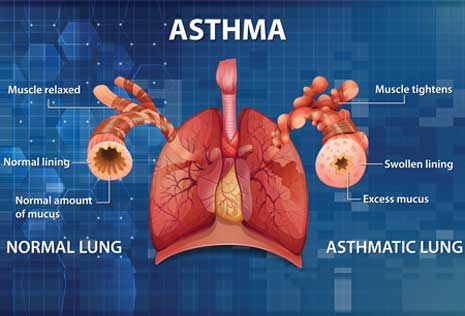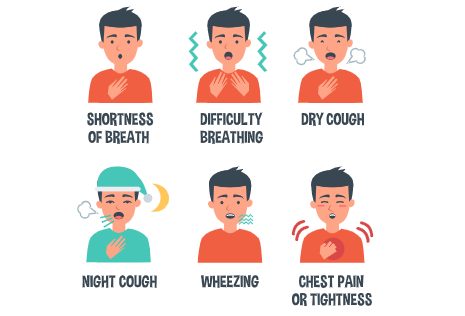Asthma

 About Asthma
About Asthma
 Asthma is an inflammatory condition of the airways to the lungs in which the airways narrow, swell and produce extra mucus. This can make breathing difficult and may trigger coughing, wheezing and shortness of breath.
Asthma is an inflammatory condition of the airways to the lungs in which the airways narrow, swell and produce extra mucus. This can make breathing difficult and may trigger coughing, wheezing and shortness of breath. For some patients Asthma can be a major problem that interferes with daily activities and may lead to a life-threatening asthma attack.
For some patients Asthma can be a major problem that interferes with daily activities and may lead to a life-threatening asthma attack.
 ASTHMA SYMPTOMS
ASTHMA SYMPTOMS
 Symptoms of asthma include:
Symptoms of asthma include:-
- coughing, especially at night, when laughing, or during exercise
- wheezing
- chest tightness
- shortness of breath
- fatigue
 The type of asthma that you have can determine which symptoms you experience.
The type of asthma that you have can determine which symptoms you experience.

 How do WE treat Asthma
How do WE treat Asthma
 Asthma can’t be cured, but its symptoms can be controlled. Because asthma often changes over time, it’s important that you work with your doctor to track your signs and symptoms and adjust treatment as needed.
Asthma can’t be cured, but its symptoms can be controlled. Because asthma often changes over time, it’s important that you work with your doctor to track your signs and symptoms and adjust treatment as needed.
 Breathing exercises
Breathing exercises
These exercises can help you get more air into and out of your lungs. Over time, this may help in increase lung capacity and cut down on severe asthma symptoms. Your doctor or an occupational therapist can help you learn these breathing exercises for asthma.
 Rescue or First aid
treatments
Rescue or First aid
treatments
These medications should only be used in the event of an asthma attack. They provide quick relief to help you breathe again. Examples include:
- Rescue inhalers and Nebulizers, which are used with medicine that need to be inhaled deep into the lungs.
- Bronchodilators, which work to relax the tightened muscles in your lung.
- Anti-inflammatories, which target inflammation in your lungs that could be preventing your breathing.
If you think that someone you know is having an asthma attack, you should sit them upright and assist them in using their rescue inhaler or nebulizer. Two to six puffs of medication should help ease their symptoms.
If symptoms persist for more than 20 minutes, and a second round of medication doesn’t help, seek medical attention.
 Long-term asthma
control Medications
Long-term asthma
control Medications
These medications should be taken daily to prevent symptoms. Some rescue treatments, such as inhalers and nebulizers, can be used daily. However, your doctor will need to adjust your dosages.
Several types of medications are used to treat asthma.
 DO’s and DON’Ts
DO’s and DON’Ts
 Asthma can’t be cured, but its symptoms can be controlled. Because asthma often changes over time, it’s important that you work with your doctor to track your signs and symptoms and adjust treatment as needed.
Asthma can’t be cured, but its symptoms can be controlled. Because asthma often changes over time, it’s important that you work with your doctor to track your signs and symptoms and adjust treatment as needed.
The key to living with asthma successfully is to keep it under control. Limit contact with asthma triggers in your environment, monitor your condition with a peak flow meter, and follow your treatment plan strictly.
Work on reducing asthma triggers. A first step is to stop smoking and protect yourself from second-hand smoke in your home and in public places.
It is possible to be active and stay healthy when you’re living with asthma. In fact, many medal-winning Olympic athletes have asthma. Exercise strengthens your respiratory muscles, helps maintain weight. Exercises that are less likely to trigger asthma symptoms include swimming, walking, hiking, and leisurely biking. Sports that have short bursts of activity are also less likely to set off symptoms. Examples include baseball, football, and sprinting.
You may have to pace yourself at times or make some adjustments here or there, such as avoiding outdoor sports in the early morning, when pollen counts are at their highest (assuming pollen is one of your triggers).
Stress can be a trigger for asthma attacks. With that in mind, commit to implementing stress-reduction strategies into your life, such as breathing exercises, meditation, and other tactics.
Stay mindful of your emotional state. People with asthma may be more likely to develop anxiety or depression. If you begin to feel down or depressed, talk with your doctor. Help is available.
Asthma presents a number of day-to-day challenges that need to be overcome. Take steps to make it easier for you to commit to these.
Simply checking and recording peak flows once per day could make a big difference in your asthma control. A low number can indicate you may be headed toward an asthma attack.
Learn how to use your medications correctly. Find out all you can about your asthma medicine, including how and when to take it, potential side effects, and how it controls your asthma. If you use a metered dose inhaler, learn how to use it properly.
Talk to your doctor about adjusting your routine if compliance is becoming an issue or you are experiencing side effects.
Not having your rescue inhaler immediately available can be dangerous. Because you have no idea when you might need it, consider keeping a spare in your backpack, purse, desk, or any place Even people who take their asthma medicine exactly as prescribed and who work to avoid triggers can have the occasional asthma attack. It’s essential to have an asthma action plan in place for those times. This will include symptoms to look for, actions to take, danger signs, avoiding triggers, medication instructions, and when to call your doctor or go to the emergency room.
Useful Material
Coming Soon
CONNECT WITH THE LEADERS IN THE SOCIETY










